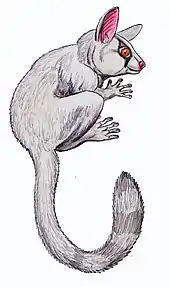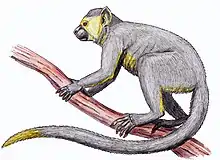| Anoiapithecus Temporal range: Miocene | |
|---|---|
| Scientific classification | |
| Domain: | Eukaryota |
| Kingdom: | Animalia |
| Phylum: | Chordata |
| Class: | Mammalia |
| Order: | Primates |
| Suborder: | Haplorhini |
| Infraorder: | Simiiformes |
| Family: | Hominidae |
| Subfamily: | Homininae |
| Tribe: | †Dryopithecini |
| Genus: | †Anoiapithecus Moyà-Solà et al., 2009 |
| Species: | †A. brevirostris |
| Binomial name | |
| †Anoiapithecus brevirostris Moyà-Solà et al., 2009 | |
Anoiapithecus is an extinct ape genus thought to be closely related to Dryopithecus. Both genera lived during the Miocene, approximately 12 million years ago. Fossil specimens named by Salvador Moyà-Solà are known from the deposits from Spain.[1]
The discoverers described Anoiapithecus brevirostris as a hominoid (superfamily Hominoidea) in the dryopithecine tribe. They believe that it has more modern traits than the Kenyapithecines from which Kenya's Kenyapithecus wickeri brings fragmentary information. The African specimens are considered a sister taxon to the hominids, and 2 million years younger European specimens must be from the time after these two groups split. This means that hominids may have evolved in Europe.[2]
The name comes from the Anoia River region in Catalonia, where the fossil was found. It has been given the nickname Lluc (since it is a male individual). The name Lluc is the Catalan form of Luke, which in Latin suggests "light", as this discovery enlighted our early evolution.[3]
The modern anatomical features that characterized the family Hominidae visible in Lluc's fossil among others are: unique facial pattern for hominoids, nasal aperture wide at the base, high cheek bone, and deep palate.[1]
See also
- Chororapithecus – Extinct hominine genus from the Miocene
- Nakalipithecus – Extinct species of ape
- Pierolapithecus – Extinct species of ape from Miocene Europe
- Samburupithecus – Extinct genus of primate from Miocene Kenya
References
- 1 2 Moyà-Solà, S.; Albab, David M.; Almécija, Sergio; Casanovas-Vilar, I; Köhler, M; De Esteban-Trivigno, S; Robles, JM; Galindo, J; Fortuny, J (2009). "A unique Middle Miocene European hominoid and the origins of the great ape and human clade". PNAS. 106 (24): 9601–9606. Bibcode:2009PNAS..106.9601M. doi:10.1073/pnas.0811730106. PMC 2701031. PMID 19487676..
- ↑ "Did first hominids live in Europe?". New Scientist. 6 June 2009. p. 17.
- ↑ "Researchers from the Institut Catala de Paleontologia describe a new hominid". EurekAlert!. June 2009. Retrieved 9 September 2019.



